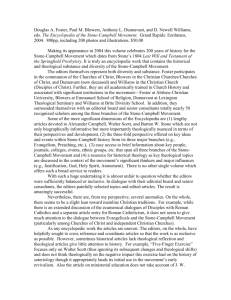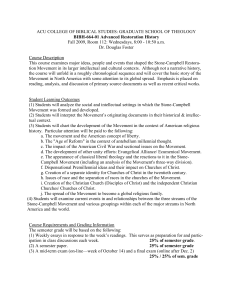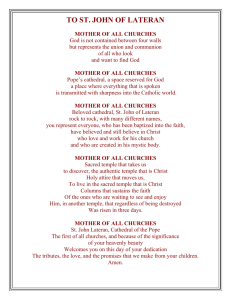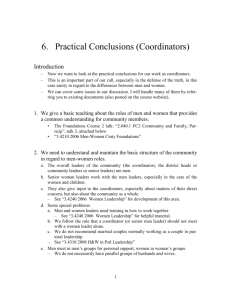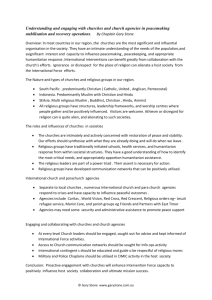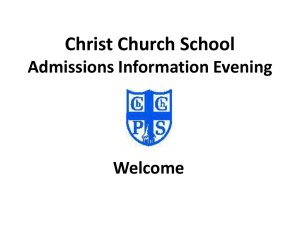ABILENE CHRISTIAN UNIVERSITY
advertisement
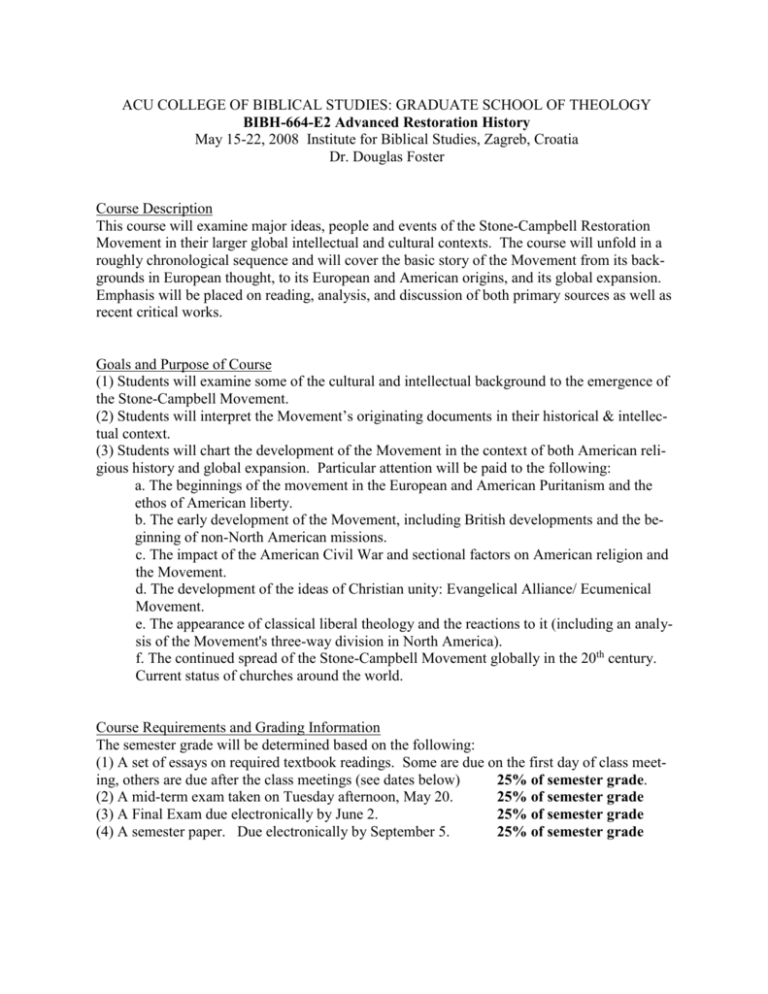
ACU COLLEGE OF BIBLICAL STUDIES: GRADUATE SCHOOL OF THEOLOGY BIBH-664-E2 Advanced Restoration History May 15-22, 2008 Institute for Biblical Studies, Zagreb, Croatia Dr. Douglas Foster Course Description This course will examine major ideas, people and events of the Stone-Campbell Restoration Movement in their larger global intellectual and cultural contexts. The course will unfold in a roughly chronological sequence and will cover the basic story of the Movement from its backgrounds in European thought, to its European and American origins, and its global expansion. Emphasis will be placed on reading, analysis, and discussion of both primary sources as well as recent critical works. Goals and Purpose of Course (1) Students will examine some of the cultural and intellectual background to the emergence of the Stone-Campbell Movement. (2) Students will interpret the Movement’s originating documents in their historical & intellectual context. (3) Students will chart the development of the Movement in the context of both American religious history and global expansion. Particular attention will be paid to the following: a. The beginnings of the movement in the European and American Puritanism and the ethos of American liberty. b. The early development of the Movement, including British developments and the beginning of non-North American missions. c. The impact of the American Civil War and sectional factors on American religion and the Movement. d. The development of the ideas of Christian unity: Evangelical Alliance/ Ecumenical Movement. e. The appearance of classical liberal theology and the reactions to it (including an analysis of the Movement's three-way division in North America). f. The continued spread of the Stone-Campbell Movement globally in the 20th century. Current status of churches around the world. Course Requirements and Grading Information The semester grade will be determined based on the following: (1) A set of essays on required textbook readings. Some are due on the first day of class meeting, others are due after the class meetings (see dates below) 25% of semester grade. (2) A mid-term exam taken on Tuesday afternoon, May 20. 25% of semester grade (3) A Final Exam due electronically by June 2. 25% of semester grade (4) A semester paper. Due electronically by September 5. 25% of semester grade Advanced Restoration History Essays 1) Each student will write an essay (single-spaced, Times New Roman 12 point font) of the length indicated for each set of readings in the units listed below. The essays are not to be simply an outline of the material or a listing of facts; rather, they are your interaction and response to the ideas presented in the readings for that unit. You might ask yourself questions like, What did you find especially interesting and why? How were your ideas challenged or changed, or what did you learn that you think was especially important for your understanding of the StoneCampbell Movement? What did you find difficult? What do you want to challenge or question? Be very specific in your essays; do not write “encyclopedia articles.” Rather I want to see you interacting with the information in your readings. You must be specific when referring to the material from your reading, not just talking in generalities. One way of looking at it is to see two components of these essays 1) reflect the material from the readings—in other words, write so I can tell you have really read the material, and 2) interact with the material so I can also see you in the essays—not just a listing of facts. You should make one copy of the essays that are due on the first class meeting to turn in to the professor, and another set of those essays to bring with you to class each day. These essays may serve as the beginning of class discussion some days. Discussion will take various forms, including oral questions asked by the teacher, discussions and consensus building in groups, identifying questions for the teacher, making choices for directions for the lecture, etc. Each individual will receive a grade of from 0 to 5 points for each of her or his essays. It will be very important to spend adequate time on the reading of the texts for each unit and the writing of the essays, since they are twenty-five percent of the course grade. While the professor will do as much grading as possible during the week of class, most will be graded after the class meetings are over. Research Project Hopefully before the course actually begins, and continuing early in the week of class in consultation with the professor, each student will chose one of two options for the course project. Option 1 Students may choose a topic from the list at the end of this syllabus or from their own interests. Proposed topics must be written out and given to the professor for approval, suggestions, and guidance as soon as possible–but no later than the beginning of class May 19. This is a standard research paper common in graduate classes. Form should follow carefully Turabian (University of Chicago) 6th edition style. There are different versions of Turabian today. Much of the information you will need for correct form can be found at http://www.bucknell.edu/Documents/ISR/turabian.pdf Option 2 The second option is to write a critical history of the Stone-Campbell Movement in a European country. This would involve standard research using reference works such as the Encyclopedia of the Stone-Campbell Movement, as well as material available from persons in the country being studied, oral history interviews, and the online resources available through the World Convention of Churches of Christ at http://worldconvention.org/nationalprofiles.php The country history project is to be a study that details and analyzes critically the life of the StoneCampbell Movement in a European country. Like option 1, your proposal must be written out Advanced Restoration History and given to the professor for approval, suggestions, and guidance as soon as possible–but no later than the beginning of class May 19. This project is not merely a chronicling of events year-by-year, or an anecdotal collection of stories. This must be a critical historical study that asks and tries to answer with extensive research and data such questions as, why did the people who brought these churches into this country do it—what were the circumstances behind their coming? Do they reflect a larger mission movement that was going on in Stone-Campbell churches at the time? How? Were the people who came prepared—did they speak the language; did they adapt to the culture of the country? What obstacles did they encounter? What problems arose? Did they handle the problems well?, etc. It is unlikely that you can tell everything about the history of the churches in any country in twenty pages, so you will most likely have to focus on one area of the country, or one church planting effort. The form can be a bit more flexible than a traditional term paper, but you must write clearly and critically, and all standard types of references (books, articles, web sites, oral history interviews, etc.) must be given in Turabian form as mentioned in Option One. Regardless of which option you choose, the final project should consist of approximately twenty pages of text with footnotes (with additional pages for accompanying illustrations or documents if desired), and will be done in three stages: A. Turn in a written proposal for your paper/project no later than May 19. B. Turn in an introduction, detailed outline and working bibliography by June 23. C. Turn in the final completed paper/project no later than September 5. Attendance Policy As an intensive graduate level class, attendance is expected and required at all class sessions. Contact with Professor During the time of the class the professor will make appointments with each student to visit regarding the semester research project and other class matters. Prior to the week of class meetings and afterward, students should contact the professor concerning ideas and questions concerning the research project or other matters dealing with the course through e-mail at fosterd@acu.edu Required Texts (1) Gary Holloway and Douglas A. Foster, Renewing God’s People: A Concise History of Churches of Christ. ACU Press, 2006. (2) Douglas A. Foster, Will the Cycle Be Unbroken? Churches of Christ Face the TwentyFirst Century. ACU Press, rev. ed., 2007. (3) Douglas A. Foster, compiler. Readings to Accompany BIBH 664. This will take the form of handouts given out during the class itself. The professor will provide these materials. (4) Nathan O. Hatch, The Democratization of American Christianity. Yale, 1989. (5) D. Newell Williams, Barton Stone: A Spiritual Biography. Chalice Press, 2000. (7) Articles from The Encyclopedia of the Stone-Campbell Movement, Eerdmans, 2005. These may be read from a library copy, or you can purchase a copy for your own. Specific readings from the above texts and/or primary source material and articles in the Readings book or on the class web page will be assigned for each unit of the class. Advanced Restoration History Other Suggested Reading: Standard Restoration Histories By scholars from Churches of Christ David Edwin Harrell, Jr., The Churches of Christ in the 20th Century, Univ. of Alabama Press, 2000. Richard Hughes, Reviving the Ancient Faith: The Story of Churches of Christ in America. Eerdmans, 1996. Leroy Garrett, The Stone-Campbell Movement, Rev. & Expanded, College Press, 1994. Bill Humble, The Story of the Restoration. Firm Foundation, 1969; reprint, Faith and Facts, 1993. Earl West, The Search for the Ancient Order: A History of the Restoration Movement, 4 vols. Gospel Advocate, Religious Book Service, 1949 ff. By scholars from Independent Christian Churches James B. North, Union in Truth: An Interpretive History of the Restoration Movement. Standard, 1994. Henry Webb, In Search of Christian Unity: A History of the Restoration Movement. Standard, 1990; revised ed. ACU Press, 2003. James DeForest Murch, Christians Only: A History of the Restoration Movement. Standard, 1962. By scholars from the Christian Church (Disciples of Christ) Mark Toulouse, Joined In Discipleship: The Maturing of An American Religious Movement. Chalice Press, 1992; revised edition 1997. Lester G. McAllister and William Edward Tucker, Journey in Faith: A History of the Christian Church (Disciples of Christ). Bethany Press, 1975. Winfred Ernest Garrison and Alfred T. DeGroot, The Disciples of Christ, A History. Bethany Press, 1948, 1958. Other Suggested Reading: Stone-Campbell Movement and American Religion Dwight Bozeman, Protestants in an Age of Science. Univ. of North Carolina Press, 1977. Jon Butler, Awash on a Sea of Faith. Harvard Univ. Press, 1990. Anthony Dunnavant, et. al., Founding Vocation and Future Vision: The Self-Understanding of Disciples of Christ and Churches of Christ. Chalice Press, 1999. Richard T. Hughes and C. Leonard Allen, Illusions of Innocence: Protestant Primitivism in America, 1630-1875. Chicago, 1988. William R. Hutchinson, Between the Times: The Travail of the Protestant Establishment in America 1900-1960. Cambridge, 1989. David W. Lotz, ed., Altered Landscapes: Christianity in America 1935-1985. Eerdmans, 1989. Martin Marty, Modern American Religion, Vol. 1, The Irony of It All: 1893-1919. University of Chicago Press, 1986. Martin Marty, Modern American Religion, Vol. 2, The Noise of Conflict: 1919-1941. University of Chicago Press, 1991. Newell Williams, ed., A Case Study of Mainstream Protestantism: The Disciples' Relation to American Culture, 1880-1989. Eerdmans, 1991. Jim Woodroof, The Church in Transition. Bible House, 1991. Robert Wuthnow, The Restructuring of American Religion. Princeton, 1988. _____________________________ Advanced Restoration History Schedule of Readings and Essays Note: All essays for Units One through Eight are due the first day of class—May 15. Essays for Units Nine through Eleven may also be turned in on that day, but may also be turned in on the dates indicated below. Unit One—Backgrounds: Holloway/ Foster, Renewing God’s People, chapters 1 and 2. 2 page essay _____________________________ Unit Two—American Context: Hatch, The Democratization of American Christianity (read all) 3 page essay _____________________________ Unit Three—The Stone Movement: Williams, Barton Stone: A Spiritual Biography (read all) Holloway/ Foster, Renewing God’s People, chapter 3. 3 page essay _____________________________ Unit Four—The Campbell Movement: Articles from The Encyclopedia of the Stone-Campbell Movement:1) Campbell, Thomas, 2) Campbell, Alexander, 3) Campbell, Selina Holloway/ Foster, Renewing God’s People, chapter 4. 3 page essay _____________________________ Unit Five—Documents of the Movement: Read the “Last Will and Testament of the Springfield Presbytery (1804),” and the “Declaration and Address of the Christian Association of Washington, PA (1809). Last Will and Testament Sent as e-mail attachment or on Blackboard web site for class Declaration and Address: http://www.mun.ca/rels/restmov/texts/tcampbell/da/DA-1ST.HTM Read pages 6-23 2 page essay _____________________________ Unit Six—The Union of the Movements: Read Holloway/ Foster, chapters 5, 6, 7 2 page essay _____________________________ Unit Seven—The Movement in the United Kingdom: Articles from The Encyclopedia of the Stone-Campbell Movement: 1) Great Britain and Ire- Advanced Restoration History land, Churches of Christ in, 2) King, David, 3) Rotherham, Joseph Bryant 2 page essay _____________________________ Unit Eight—Millennialism, Civil War, and Ideas of Unity: Read Holloway/ Foster, chapter 8 Article from The Encyclopedia of the Stone-Campbell Movement: Unity, Christian. 2 page essay _____________________________ Unit Nine—The Development of three streams of the Stone-Campbell Movement in North America and Internationally: Read Holloway/ Foster, chapters 10, 11, 12 Articles from The Encyclopedia of the Stone-Campbell Movement: 1) Christian Church (Disciples of Christ), 2) Christian Churches/Churches of Christ, 3) Churches of Christ. 3 page essay (must be turned in no later than Saturday, May 17, the first week of class) _____________________________ Unit Ten—The Shape of the SCM Movement in the 21st Century Read descriptions of the SCM in ten European countries on the World Convention of Churches of Christ website http://www.worldconvention.org/nationalprofiles.php 3 page essay (must be turned in no later than Thursday, May 22, the second week of class) _____________________________ Unit Eleven—The Future of the Stone-Campbell Movement: Read Holloway/ Foster, chapter 13 Read Foster, Will the Cycle Be Unbroken? 3 page essay (must be completed and sent electronically to the professor no later than Thursday, May 29, the week after class) _____________________________ Course Outline/Class Schedule Thursday, May 15 8:30am-12:30pm, 1:30pm-4:30pm A. Introduction to Course. General discussion of topics for research. Personal connections to the Stone-Campbell Movement. B. Origins: 1) Intellectual framework supplied by Enlightenment and Romantic thought. Discussion of Nathan Hatch, The Democratization of American Christianity 2) The Barton Stone Movement. Discuss Newell Williams, Barton Stone: A Spiritual Biography. Examine "Last Will and Testament." Advanced Restoration History Friday, May 16 8:30am-12:30pm, 1:30-4:30pm 3) The Campbell Movement. Examine "The Declaration and Address." 4) Compare and contrast the Stone and Campbell Movements sociologically, intellectually, theologically. 5) Discussion of the "union" of the Movements in light of contemporary ideas of Christian unity. Examination of how the Movement fit into the "Age of Reform" in the early 19th century. 6) Origins of the Movement in the United Kingdom Saturday, May 17 8:30am-12:30pm C. The American millennial ethos and the Movement. D. Sectionalization and Civil War as a factor in shaping American religion and the Movement. Monday, May 19 8:30am-12:30pm, 1:30-4:30pm E. The development of ideas of Christian unity in American religion in the 19th century and the Stone-Campbell Movement's reaction. F. The increasing importance of liberal theology on American religion in the late 19th century. The stances taken by the leaders in the Movement to biblical criticism and the uniqueness of Christianity. Examination of the differences in what would become the three major groups. Tuesday, May 20 8:30am-12:30pm, 1:30pm-4:30pm G. The attitude about the new century, World War I, millennial ideas associated with world events. Millennialism in American religion and the Movement. H. The fundamentalist crisis of the 1920s and the relation of the various segments of the Movement to it. I. The second major division in the SCM in North America. The shape of the movement at mid-twentieth century. Mid-term exam 1:30-4:30 Advanced Restoration History Wednesday, May 21 8:30am-12:30pm J. The Movement and the crises of the 1960s. Social consciousness/ social abdication. K. Factors now shaping the movement, characterization of the streams in North America, and predictions for the future. L. The global face of the Stone-Campbell Movement. World Convention of Churches of Christ. Thursday, May 22 M. Final wrap-up. Discussion of final exam. Discussion of semester projects. Thursday, May 29 Last Essay Due Monday, June 2 Deadline for returning Final Exam to professor electronically: 12:00 noon Monday, June 23 Deadline for sending Introduction, Outline, and Bibliography to professor Friday, Sept 5 Deadline for sending final draft of semester paper/project Some Possible Research Areas for Papers NOTE: These are not ready-to-use topics or titles. Develop and refine, or supply an alternative. State your topic in the form of a question or problem, i.e. "What accounts for the vast differences between Barton Stone and Alexander Campbell?" 1. Barton W. Stone's view of the atonement, or baptism, or another specific doctrine. 2. Puritan backgrounds to Stone-Campbell theology: baptism, Eucharist, etc. 3. The relationship between the Shaker communities and the Stone movement. 4. Thomas Campbell's Irish experiences with Christian division and unity. 5. Theological underpinnings of the Presbyterian Church in the United States of America or the Baptist denomination(s) and the effect of one of those bodies on the Stone-Campbell Movement. 6. The relations between Churches of Christ and the Baptist Churches, Presbyterian Churches, Methodist Churches, etc., in America, in Europe, in Africa, etc. 6. The Stone-Campbell Movement's relations with other primitivist/ restorationist movements or unity movements. 7. The missionary efforts in the Stone-Campbell Movement—19th century, 20th century. 8. Patriotism / nationalism and the Stone-Campbell Movement churches globally. 9. Pacifism and the Stone-Campbell Movement. Advanced Restoration History 10. Millennial thought in the Movement. 11. Concepts of theological liberalism and how they have affected the Movement. 12. Reactions to "liberal theology" in the broadest sense, i.e., Biblical criticism, evolution, comparative religion, etc. 13. The relationship of the Churches of Christ to the American fundamentalist establishment. 14. The background and development of the anti-institutional controversy in Churches of Christ. 15. Continuing relations between Churches of Christ, Disciples and "Independents." 16. Historical changes in worship styles in the Movement. 17. Mission work in Churches of Christ. 18. The social consciousness of Churches of Christ. 19. The Civil Rights Movement and Churches of Christ. 20. Racial makeup of Churches of Christ--Black Churches of Christ a separate group. Churches of Christ in older mission fields. 21. Current contrasts and similarities between the three major groups from the Stone-Campbell Movement. 22. Diversification of theological positions within contemporary Churches of Christ; Christian Churches. 23. The concept of Christian unity and the efforts toward unity among the different parts of the Movement. [At every turn you must constantly ask "why?" Although there will be times when you cannot arrive at a conclusive answer, be rigorous in your investigation of the problem factually and analytically.]
